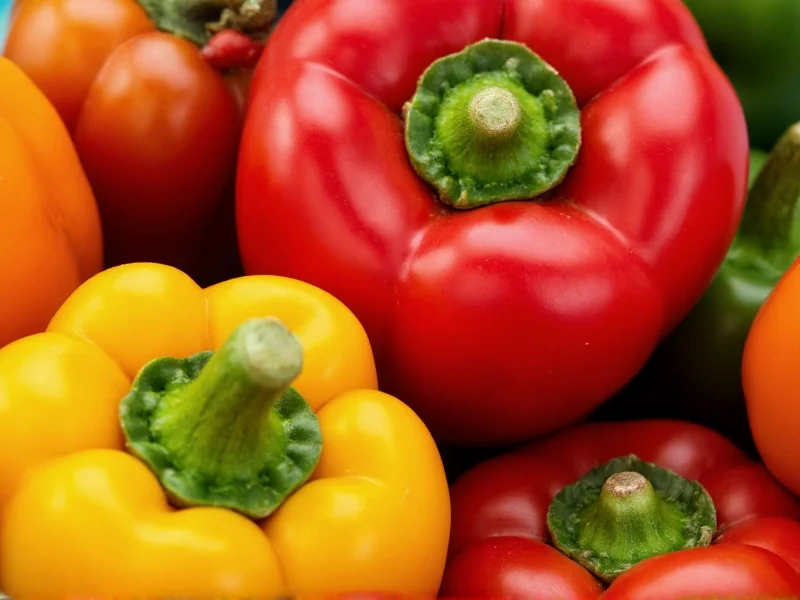When comparing pepper sweetness, understanding the ripening process is essential. As peppers mature on the plant, they convert starches to sugars while developing more complex flavor compounds. This explains why fully ripe red bell peppers taste significantly sweeter than their green counterparts, which are harvested earlier.
The Science Behind Pepper Sweetness
Pepper sweetness primarily depends on two factors: variety and ripeness. The Scoville scale, which measures capsaicin concentration, indirectly indicates potential sweetness since sweet peppers register at the lowest end (0–500 Scoville Heat Units), while hot peppers range from 1,000 to over 2,000,000 SHU.
Contrary to popular belief, color indicates ripeness rather than variety. A single bell pepper plant produces green peppers first, which gradually ripen to yellow, orange, and finally red. This ripening process increases sugar content by up to 30% while decreasing chlorophyll.
Sweet Pepper Varieties Compared
Not all peppers marketed as “sweet” deliver equal sugar content. Here's how common varieties compare based on objective measurements of Brix (sugar content) and Scoville ratings:
| Pepper Variety | Typical Brix (Sugar Level) | Scoville Heat Units | Flavor Profile |
|---|---|---|---|
| Red Bell Pepper | 6.5–8.0 | 0 | Fruit-forward, sweetest common variety |
| Yellow Bell Pepper | 5.5–7.0 | 0 | Bright, slightly floral sweetness |
| Orange Bell Pepper | 5.0–6.5 | 0 | Balanced sweet-tart flavor |
| Green Bell Pepper | 3.5–5.0 | 0 | Grassy, slightly bitter |
| Cubanelle | 4.0–5.5 | 100–1,000 | Mildly sweet with subtle heat |
| Banana Pepper | 4.5–6.0 | 0–500 | Tangy-sweet, often pickled |
Why Red Bell Peppers Win the Sweetness Contest
Among all commonly available peppers, red bell peppers consistently demonstrate the highest sugar content. Research from the University of California’s Agriculture Department shows that fully ripened red bells contain approximately 30% more natural sugars than green bells of the same variety. This sweetness develops as chlorophyll breaks down and carotenoids (which give red peppers their color) increase during extended vine ripening.
Interestingly, the same study revealed that sweetness varies even within red bell peppers depending on growing conditions. Peppers grown with consistent moisture and harvested after 21 days of color development showed 15–20% higher sugar content than those harvested earlier or grown in drought conditions.
Common Misconceptions About Pepper Sweetness
Many home cooks mistakenly believe that thinner-walled peppers are sweeter, but wall thickness primarily affects texture rather than sugar content. Similarly, the notion that smaller peppers are always hotter doesn't apply to sweet varieties—mini sweet peppers are specifically bred for consistent sweetness regardless of size.
When selecting peppers for maximum sweetness, focus on these indicators:
- Deep, uniform color without green streaks (especially important for red peppers)
- Firm, glossy skin that springs back when gently pressed
- Heavy weight relative to size, indicating higher water and sugar content
- Fully developed shoulders at the top of bell peppers
Practical Applications in Cooking
Understanding pepper sweetness helps optimize recipes. For raw applications like salads or crudités, red bell peppers provide the most pronounced sweetness. When cooking, remember that heat breaks down some sugar compounds, so yellow peppers often maintain better sweetness balance in roasted dishes.
Chefs specializing in flavor development note that combining pepper varieties creates more complex sweetness profiles. A blend of red and yellow bell peppers, for instance, delivers both deep caramel notes and bright fruity flavors that single varieties can't match.
Measuring Sweetness at Home
Without laboratory equipment, you can assess pepper sweetness through simple methods:
- Taste test small pieces of different varieties side by side
- Observe color intensity – deeper reds typically indicate higher sugar content
- Check for shiny, taut skin which suggests proper ripeness
- Smell the pepper – sweet varieties emit a distinct fruity aroma
For recipe development, consider that sweetness perception changes with temperature. Peppers taste sweeter when served at room temperature compared to chilled, making proper storage crucial for flavor optimization.











 浙公网安备
33010002000092号
浙公网安备
33010002000092号 浙B2-20120091-4
浙B2-20120091-4